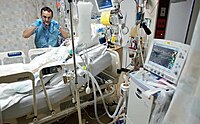
Photo from wikipedia
Lack of critical care resource in face of COVID‐19 epidemics Based on data reported by the National Health Commission of China, there have been about 2000 new confirmed cases and… Click to show full abstract
Lack of critical care resource in face of COVID‐19 epidemics Based on data reported by the National Health Commission of China, there have been about 2000 new confirmed cases and > 4000 suspected cases daily over the past week in Wuhan [3]. About 15% of the patients have developed severe pneumonia, and about 6% need noninvasive or invasive ventilatory support. Currently, there are about 1000 patients who need ventilatory support and another 120 new patients daily who require noninvasive or invasive ventilation support in Wuhan city; however, there are only about 600 ICU beds [4]. To address this shortfall, 70 ICU beds were created from general beds and the government quickly transformed three general hospitals to critical care hospitals with a total of about 2500 beds that specialize in patients with severe SARS-CoV-2 pneumonia (equipped with monitors and high-flow nasal cannula, noninvasive ventilator or invasive ventilators). An equally great (or potentially greater) problem is the shortage of trained personnel to treat these critically ill patients. Until the crisis, there were about 300 ICU physicians and 1000 ICU nurses in Wuhan city. By the end of January, more than 600 additional ICU doctors and 1500 ICU nurses were transferred to Wuhan from the rest of China. As well, an additional 3000 staff including infectious disease, respiratory, internal medicine physicians and nurses were transferred to Wuhan by the government. There are logistical issues which make care of the patients difficult. These include donning of personal protective equipment (e.g., gloves, gowns, respiratory and eye protection), lack of instruments and disposables, and shortages of supplemental oxygen. Many severe hypoxemic patients only receive high-flow nasal oxygen (HFNO) or noninvasive mechanical ventilation rather than invasive mechanical ventilation because of intubation delay or lack of mechanical ventilators (especially at early phase). Our preliminary data show that only about 25% of patients who died were intubated and received mechanical ventilation.
Journal Title: Intensive Care Medicine
Year Published: 2020
Link to full text (if available)
Share on Social Media: Sign Up to like & get
recommendations!